Employee motivation is crucial because it affects the whole team leading to profit loss for the company. At the same time, it is worth emphasizing that the level of employee motivation has plenty of variables. For instance, occasionally some employees may have a bad day for whatever reason, that’s normal and acceptable. However, when such days happen suspiciously often to a decent proportion of workers, their superior or a manager should act. What can they do on a daily basis that can effectively motivate employees? We would like to present some ideas on how to figure it out get your team into fine and cheerful shape in today’s article.
How to motivate employees – table of content:
- Finances are not everything or financial motivation used with caution
- Which daily behaviors of supervisors are most effective in motivating employees?
- Work-life balance, or a human approach to the team
- Fruit Thursdays – does it make sense?
- Negative motivation – team leader, don’t go that way!

Finances are not everything or financial motivation used with caution
It is a mistake to assume that people today work only to earn money. Understandably, the financial incentive remains significant as it provides workers to satisfy their basic needs. Nevertheless, reckoning that employees do their work only for the money can paradoxically result in the decreased motivation of employees. How is this possible?
Actually, it all comes down to the fact that there have been a few different kinds and categories of motivation presented by psychologist and behaviorist. In short, motivation is intrinsic (coming from within, like the need to be good at something, have autonomy and meaning in one’s actions) or extrinsic (connected with external factors like reward, lack of punishment or compensation. Moreover, motivation can be physical (financial reward, goods) or psychosocial (words of praise, honoring in front of others, supporting a team etc.) Better yet, motivation can be instrumental (you do something to get reward) or integral (you do something to be different, like go to church or meditate).
In the context of business, it seems that the old ways of managing a team were mainly focused on extrinsic, physical and instrumental kinds of motivation. Today however, professional and personal development plays an important role, so it is work that should stimulate it. The obsolete view that the only way to prompt employees is the promise of a raise or a bonus causes a decrease in the will to perform well and decay of the team. These processes may lead to employee migration, which in turn has a very negative impact on communication within the team. All end up in poorer performance and reduced motivation or even loss of positions for both supervisor and subordinates.
That is also why financial incentive should accompany other kinds of motivation. Additionally, we need to keep in mind that various incentives supervisors opt for should include a wide range of factors and circumstances, depending on the nature and environment of the team they lead. For instance, the age of employees. According to HR specialists’ observations, Millennials (Generation Y) and Zetas (generation Z) want to take an active part in the company’s development and are motivated by the possibility of development.
Which daily behaviors of supervisors are most effective in motivating employees?
Being a manager or team leader is a very responsible position as your daily actions and words directly affect employees. Although a plethora of novel incentives are gaining popularity among prescient team leaders and managers, it is only the effective application of these techniques that brings about a positive change.
Many supervisors underestimate the power of positive feedback is. The awareness that the work performed by the employee is sound and valuable can do wonders. From a purely sociological point of view, it seems plain and simple, even natural as it’s a primal drive to belong and feel needed in a group. When workers feel appreciated and know that what they do has a purpose, their performance skyrockets.
That is why the daily feedback from superiors to team members is so essential and uplifting. Of course, it is not about “sweetening” and praising for each duty performed, but recognizing input or insight arouses a sense of pride boots self-esteem.
Another very influential behavior that affects employee motivation is not being constantly in control and providing employees with autonomy and space for maneuver. No one likes to be constantly scrutinized, so a working model where the supervisor is constantly looking over the hands of their employees only contributes to the erosion of the team. Employees from generations Y and Z, in particular, pay attention to the frequency of being audited. We should understand that giving inferiors independence greatly contributes to stimulating creativity, which is also considered to be one of the major work incentives.
Work-life balance, or a human approach to the team
An imbalance between work and personal life may disastrously impact both. It is impossible to work all the time because then the work would be quite inefficient. It is for this reason that managers should pay special attention to the proper time management of their team. Frequent overtime, bi-weekly business trips don’t motivate employees but on the contrary, they make workers feel overwhelmed and burnt out because they don’t have time to rest, meet with friends and family.
Moreover, many team leaders nowadays recognize that skillful time management of the whole team brings about far better results than forcing people to work beyond their limits. This is the reason why a 4-day workweek is being tested in some companies. When it comes to everyday reality, it is also possible to apply a motivating work-life balance.
Let’s imagine a situation in which employees are particularly tired, after a hard day’s work – the following hours pass at a tortoise’s pace, and the team only looks at the clock to finally come to the desired end of work. Will their work be productive and efficient? Not! A cunning supervisor can give the employees a choice – if they complete their tasks by a certain time, then everyone (including the supervisor) finishes earlier. This approach will enable the team to do their best as hard as they can. And no doubt, they will do all tasks not only faster but also better than if they had to stay at work until the statutory 8 hours. Better yet, what if the cunning supervisor offered them some cold beer to top up the bet.
Jokes apart, according to experts, modern employees prefer to work shorter and more intensively, rather than “do” 8 hours, during which they will do practically nothing.
Fruit Thursdays – does it make sense?
One of the next methods for supervisors to motivate employees daily is to provide them with constant stimulation. Fruit Thursdays, pizza Fridays, are quite common ways to engage and diversify monotonous and repetitive work. Such attractions should come with moderation and caution. Still, everyone will admit that a surprise pizza from corporate can make a change. Positive influence on employees’ motivation results from the fact that they break the pattern of performing the same duties every day, with the same people, in the same circumstances.
Negative motivation – team leader, don’t go that way!
Negative motivation is a type of cheering up employees by creating threatening situations. Downsizing, the specter of layoffs, cost-cutting, and salary reductions are just some ways to negatively motivate. This kind of team management is very short-sighted and, in the long run, has only negative consequences for the whole team, which, of course, translates into results and profit for the whole company. What is more, the stability of employment does not influence the motivation of employees (especially young ones) that much nowadays. Many are more focused on gaining experience and searching for their way rather than on working all their life in one job.
Incomparably more effective than negative incentive is a friendly atmosphere at work – mutual respect between employees and superiors, understanding and empathy, can effectively motivate employees to perform their duties.
To sum up, the superiors have many ways to motivate employees daily. Positive feedback, a friendly atmosphere at work, development opportunities and stimulation of creativity can do wonders when it comes to motivating a team, which is why we have seen a significant change over the last decade when it comes to how superiors manage their teams.
You may also like: How to handle employee burnout?
If you like our content, join our busy bees community on Facebook and Twitter.
Author: Nicole Mankin
HR manager with an excellent ability to build a positive atmosphere and create a valuable environment for employees. She loves to see the potential of talented people and mobilize them to develop.


















